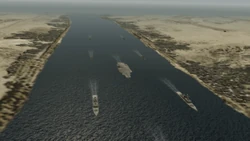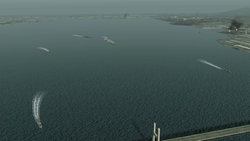The 3rd Osean Naval Fleet was a fleet division of the Osean Maritime Defense Force. It was one of the most battle-hardened forces in the Osean navy, having served in both the Belkan War and Circum-Pacific War. The fleet's flagship was the Hubert-class aircraft carrier Kestrel, and its home port was St. Hewlett, Osea.
History[]
The 3rd Osean Naval Fleet was formed sometime in the 16th century by Admiral Stafford, who earned the nickname "Father of the Navy".[1]
Belkan War[]

3rd Fleet ships sailing through Futuro Canal
Sometime in early 1995, the Osean Federation's newest aircraft carrier, the OFS Kestrel, joined the 3rd Fleet to begin preliminary testing. The fleet's first known combat operation occurred on April 24, when the Kestrel and its warships sailed through the Futuro Canal. Despite fierce resistance from the Belkan occupation forces, the 3rd Fleet suffered only light damage and successfully secured a sea transit route for the Allied Forces.[2] Sometime later, the Kestrel officially joined the 3rd Fleet and became its designated flagship.[3]
Circum-Pacific War[]
Early engagements[]

3rd Fleet ships attempting to flee St. Hewlett
The 3rd Osean Naval Fleet later became a pivotal element in the Circum-Pacific War. On September 27, 2010, at 1433hrs, the 3rd Fleet fell under attack by Yuktobanian aircraft while it was docked at St. Hewlett. The anchored Osean warships were caught off-guard, and many vessels were sunk at anchor. The Kestrel quickly launched its carrier air wing, VFA-206, to defend and protect the fleet as it made way towards the port exit. Through the valiant efforts of VFA-206 and the rookie Wardog Squadron, the 3rd Fleet escaped the harbor and broke through a Yuktobanian naval blockade. Despite this partial success, the fleet and its support personnel suffered considerable casualties.[4]
Three days later, on September 30, the 3rd Fleet's carrier strike group—which consisted of the OFS Vulture, Buzzard, and Kestrel—rendezvoused at Eaglin Straits in preparation for Osea's counterattack against Yuktobania.[5] During the operation, the Osean warships fell under attack by more Yuktobanian aircraft. Although the Osean escort fighters successfully shot down the hostiles, the 3rd Fleet suffered tremendous casualties as a result of the submersible carrier Scinfaxi's burst-missile attacks: the Vulture, Buzzard, and an escort frigate were sunk, and all of the Osean aerial forces (except Cpt. Marcus Snow and the Wardog pilots) were annihilated; only the Kestrel survived the incident.[6]
Provisional reserve status[]
As the war progressed, the 3rd Fleet presumably participated in various combat operations in the Ceres Ocean. The exact number and details of these engagements remain unknown; it is known, however, that the Kestrel's air wing lost a considerable number of airmen, until it was placed in reserve. Sometime in either November or early December 2010, the 3rd Fleet accompanied its flagship to Kirwin Island, where the vessels became temporarily stationed.[7]
Around that time, the 3rd Fleet halted and seized a Belkan cargo vessel that was attempting to smuggle fighter aircraft into Yuktobania. In addition, the fleet's intelligence-gathering vessel, the OFS Andromeda, intercepted a mysterious transmission encoded in Belkan. These events intrigued the fleet's commanding officer—the Kestrel's captain, Nicholas A. Andersen—who had become suspicious of his nation's aggressive war efforts.[7]
Razgriz operations[]
After the Wardog pilots were branded as traitors and escaped Sand Island Air Force Base, they were recovered from the Ceres Ocean and brought aboard the Kestrel. Following Osean President Vincent Harling's rescue from captivity on December 9, the vessels of the 3rd Fleet were placed under the direct command of the president.[8] Over the coming weeks, the fleet supported the newly formed Razgriz Squadron in its efforts to eliminate the nuclear warheads that the Grey Men planned to use against both Osea and Yuktobania.[9][10]
Unofficial disbandment and reformation[]
On December 29, at 1721hrs, the 3rd Fleet was engaged by a large armada of Yuktobanian warships. During the battle, several Yuktobanian vessels defected to the 3rd Fleet in order to protect the Yuktobanian Prime Minister, Seryozha Viktrovich Nikanor, who had recently come aboard the Kestrel following his liberation on December 22.[11] After the hostile Yuktobanian warships had been eliminated, another Osean fleet approached the coalition and opened fire, but was sunk by the Razgriz fighters. Following this resounding victory, Captain Andersen reorganized the 3rd Fleet and the Yuktobanian warships into a new, allied battle fleet.[12] It is unknown what restructuring the 3rd Fleet possibly underwent following the conclusion of the war.
Vessels[]
The following is not a comprehensive list, as the names of the vessels lost during the Bombing of St. Hewlett on September 27 remain unknown:
- Hubert-class aircraft carriers
- OFS Kestrel (Flagship)
- OFS Vulture
- OFS Buzzard
- Ticonderoga-class anti-aircraft Aegis cruiser
- Raleigh-class landing ship / intelligence vessel
- Hatakaze-class guided-missile destroyers
Gallery[]
The 3rd Fleet during Offensive Campaign No. 4101
OFS Buzzard with an escort frigate
References[]
- ↑ 1.0 1.1 Commander, Third Fleet. Retrieved on 5 October 2017.
- ↑ Operation Costner, Juggernaut, Ace Combat Zero: The Belkan War.
- ↑ PS2/エースコンバット5 | BACKGROUND | 設定資料. Retrieved February 28, 2015.
- ↑ Narrow Margin, Ace Combat 5: The Unsung War.
- ↑ Briefing, Rendezvous, Ace Combat 5: The Unsung War.
- ↑ Rendezvous, Ace Combat 5: The Unsung War.
- ↑ 7.0 7.1 Cutscene 20, Ace Combat 5: The Unsung War.
- ↑ Cutscene 21, Ace Combat 5: The Unsung War.
- ↑ Closure, Ace Combat 5: The Unsung War.
- ↑ Ghosts of Razgriz, Ace Combat 5: The Unsung War.
- ↑ Cutscene 24, Ace Combat 5: The Unsung War.
- ↑ Sea of Chaos, Ace Combat 5: The Unsung War.
- ↑ 13.0 13.1 Radio chatter during Sea of Chaos, Ace Combat 5: The Unsung War. Recorded at Acecombat BBS MISSION 26 混迷の海. Retrieved October 19, 2016.



